How Did Downtown Oakland Go From This to This?
By Kevin Heffernan
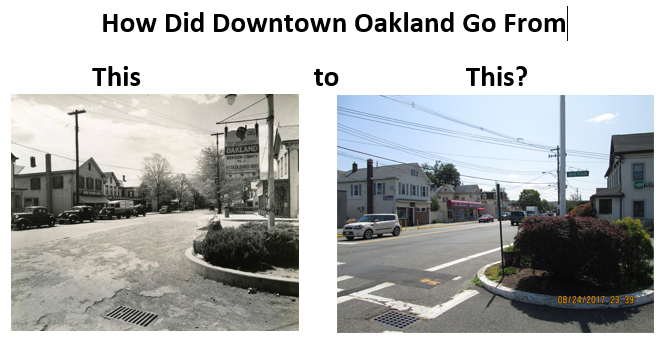
Ladies and gentlemen, lend me your ears and hearts as I will tell you a true and tragic story of downtown Oakland. It is a story that will bring tears to your eyes for what was and now lost and the decline of what is and what remains. I will tell you a very sad, tragic truth, a truth of the destruction and decline of our historic downtown.
Up until the late 1950s, Oakland was truly a Mayberry, a backwoods section of Bergen County. Route 208 wouldn’t arrive to Oakland for several years although it was planned and approved during the Great Depression. Many streets were still unpaved and in fact Oakland introduced an ordinance in the 1950s that taxed outhouses albeit that it did not distinguish between a ‘one holer’ and a ‘two holer’. Our business district on Ramapo Valley Road was filled with 3 story Victorian homes and small businesses and the Bush General Store would soon become the beloved Wigwam, the icon of an entire generation. Commuters took the never-really-on-time trains from Oakland’s railroad station built in 1872 at Bush Plaza and Oakland’s teenagers competed with the cadets of the Oakland Military Academy for dates with the local bells.
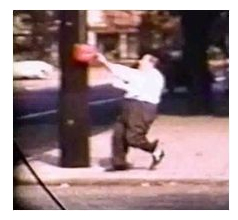 Kids went fishing, traced brooks to their source and plinked empty cans with their prized .22 caliber rifles they got for Christmas. Families and kids went to Pleasureland, Mullers or any one of the 9 beaches that lined the Ramapo River at the time. Listen well to Tom Springler’s song, Small Town Days. He’s a native son of Oakland and his fantastic song presents a true picture of how it was. Crime was non-existent with the help of Oakland’s Police department which numbered less than 10 officers under the watchful eye of Captain Joe Woods. Fires were reported to Art Seel’s Bar and Grill who in turn alerted the heroes of the Oakland Volunteer Fire Department. Yup, it was Mayberry.
Kids went fishing, traced brooks to their source and plinked empty cans with their prized .22 caliber rifles they got for Christmas. Families and kids went to Pleasureland, Mullers or any one of the 9 beaches that lined the Ramapo River at the time. Listen well to Tom Springler’s song, Small Town Days. He’s a native son of Oakland and his fantastic song presents a true picture of how it was. Crime was non-existent with the help of Oakland’s Police department which numbered less than 10 officers under the watchful eye of Captain Joe Woods. Fires were reported to Art Seel’s Bar and Grill who in turn alerted the heroes of the Oakland Volunteer Fire Department. Yup, it was Mayberry.
But the storm clouds that wrought the destruction of downtown Oakland were gathering on the horizon. The ferocity of the pending storm was seeded and amplified by people, thousands of people who came to Oakland to settle in and establish roots. Indeed, Oakland’s population increased by almost 5X from 1950 to 1960 with the building of almost 300 new homes per year for many years during the decade. And it was also late in this decade that the malls on Route 4 opened: The Garden State Plaza and the Bergen Mall. Their impact was virtually immediate as they decimated almost every small town business district in Bergen County. But, Oakland had no real business district. In the mid 1950s one would have to travel to Pompton Lakes for anything beyond a quart of milk. Since we had no real shopping, we were safe from the ravages of the new malls.
Or were we? Although we had no shopping to speak of, we nonetheless had a lot of land along Ramapo Valley Road and a burgeoning population, a siren song to potential developers. We also had new residents and thousands and thousands of them who wanted to shop locally. Bad times were coming to our classically Victorian downtown Oakland. Worse, the advent of those bad times was encouraged by the then mayor and counsel, elected officials with equal parts of no respect for our architectural heritage coupled with a massive lack of vision. A bad moon was on the rise then in Oakland.

It’s appropriate at this moment to literally set the stage. It’s the late 1950s and after crossing the RR tracks on Ramapo valley Road on the left side there was the famous Seel’s Bar and Grill dating from the late 1800, the Oakland Inn , then several Victorian stores including the McNomee store, the Hafel House , the huge Victorian Oakland Military Academy and finally the Nielsen House . On the left side there was the Oakland RR Station, the Yoeman House, four single story stores dating back to the 1930s , the Penny House and the 1924 Ponds Church. That was it. After that on both sides of the road there was nothing but mostly empty fields, former farms. This was a tiny but massively vulnerable downtown most of whose historic roots were about to be destroyed.

Enter Art Seel, the owner of a famous bar and grill on the Northeast corner of Ramapo Valley Road and Yawpo Ave which held his name. Mr. Seel was the first to see the opportunity for expanded shopping with the newly coined term, strip mall: Small stores in the rear with parking in the front. Accordingly, he initially built four joined stores behind his bar. But soon he realized that his bar was in the way of his mini mall. And besides, rent from mall tenants was more profitable than his bar. So, he demolished it and moved his bar to where Pete and John’s Paint Store is today. The bar did not succeed as one cannot transport heritage. The magic and the original building were gone.

Oakland decided in 1958 that its tiny post office was entirely inadequate for its growing population. The only question was where to build a new one. Alas, the 1872 Oakland RR station, built by David C. Bush, was eyed as a prime location. All was good as Oakland owned both the station building and the property upon which it was built. Besides, fewer people were taking the railroad and service was seriously declining. The Oakland RR station was destroyed in 1956 amidst an orgy wild-eyed destruction of our heritage in favor new development, a new post office which itself was thankfully destroyed within 25 years.

Then around 1959, the Grand Union built a super market in the mall in a former farm field where the Ponds Church is currently located. While it was bigger than the Seel’s strip mall, it was ultimately still too small. The siren song of more, bigger, better echoed throughout the valley and developers salivated while looking across the street at the Oakland Military Academy with over 200 acres of prime land and an ‘old’, grand sprawling Victorian building, the former Calderwood Hotel and home of the Calder family the core of which dated back to the 1700s. The Academy suddenly received numerous code violations and no amount of fixing them was good enough. John Sarka, who founded the Academy in the 1930s, finally gave up and moved the Academy to Orange County.
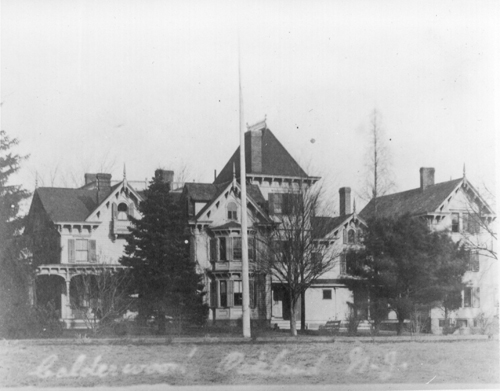
But unknown to most is that the Academy also owned several 3-story Victorian buildings on Ramapo Valley Road in the business district including the historic Oakland Inn where Krausers is currently situated. . When the core Academy buildings were purchased, so were those several it owned along RVR as part of the deal. And so it was that when the Academy building was destroyed, so were those that it owned. The destruction of Oakland’s heritage along RVR was sudden, swift, massive and tragic. The instant effect was akin to seeing a beautiful woman smiling but who also is missing every other top tooth.

There are two additional elements to complete this tragic picture and I would be remiss if I did not include them: The removal of the trees along RVR and the razing of the Nielsen House on RVR.
Ramapo Valley Road, aka Rt. 202, is a county road and has been since the 1930s. In 1955 then Mayor Potash asked for public opinion about keeping or removing the trees. In the early 1960s Bergen County decided to widen it to facilitate traffic flow. OK, but our 19th Century maple tree canopy trees along the business district were in the way. Literally, during the dark of night and without notice, county trucks and chain saws arrived to remove them. Although residents awoke in the morning with a sense of horror and outrage, it was too late. They were gone and our business district was laid bare with the loss of our country charm. Our beautiful lady of downtown Oakland was now missing all makeup in addition to missing front teeth.
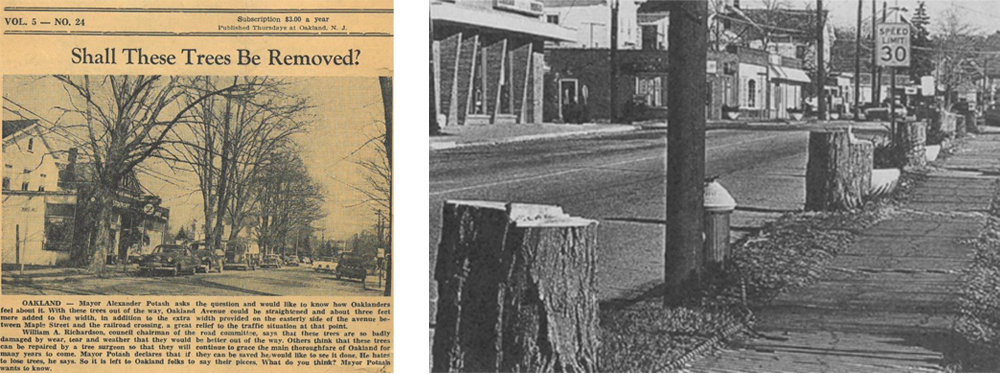
Last but certainly not least is the razing of the Nielsen House. It was a beautiful Victorian house located on the corner of RVR and East Oak Street. Well, it seems that having one major supermarket, the Grand Union, was just not sufficient as the A&P wanted a piece of the Oakland action as well. Enter another strip mall directly adjacent to the then new Grand Union mall. But the A&P was not successful and the building was subsequently occupied by the Oakland Post Office. But the mall developers needed more parking space and, like the original Seel’s Bar and Grill, the Nielsen House was sacrificed to the parking lot gods.
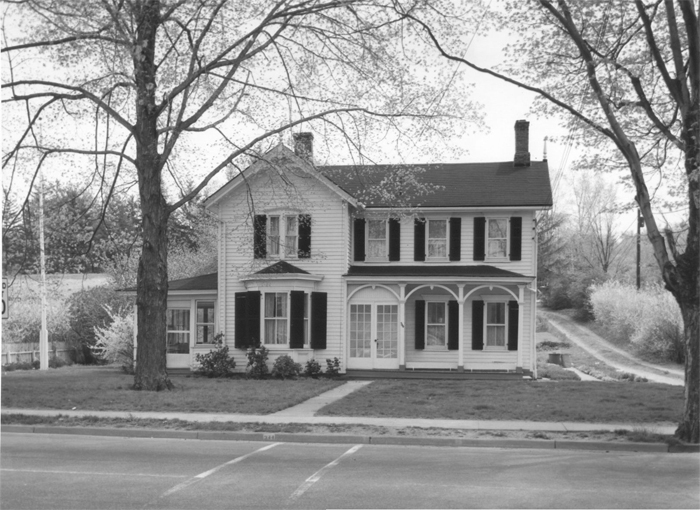
So there you have it. Downtown Mayberry then to whatever you want to call it today. All of this begs just one question: What will tomorrow bring?

Excellent article!!
Nice article. This jogged my memory of my families years there. We moved in around 1957 until 1968, we’ll known, those wild Savages as was commonly heard. My first job was at that post office. My teenage skin was a direct result of the Wigwam. Pat Saracena (whom is just an hour from me and still my best friend) and I would get a bowl of sauce and bread after school each day as our snack. French fries and comes? Not us Jersey Girls! Very fond memories. We visit every few years but it’s harder and harder recognizing the Oakland we loved.